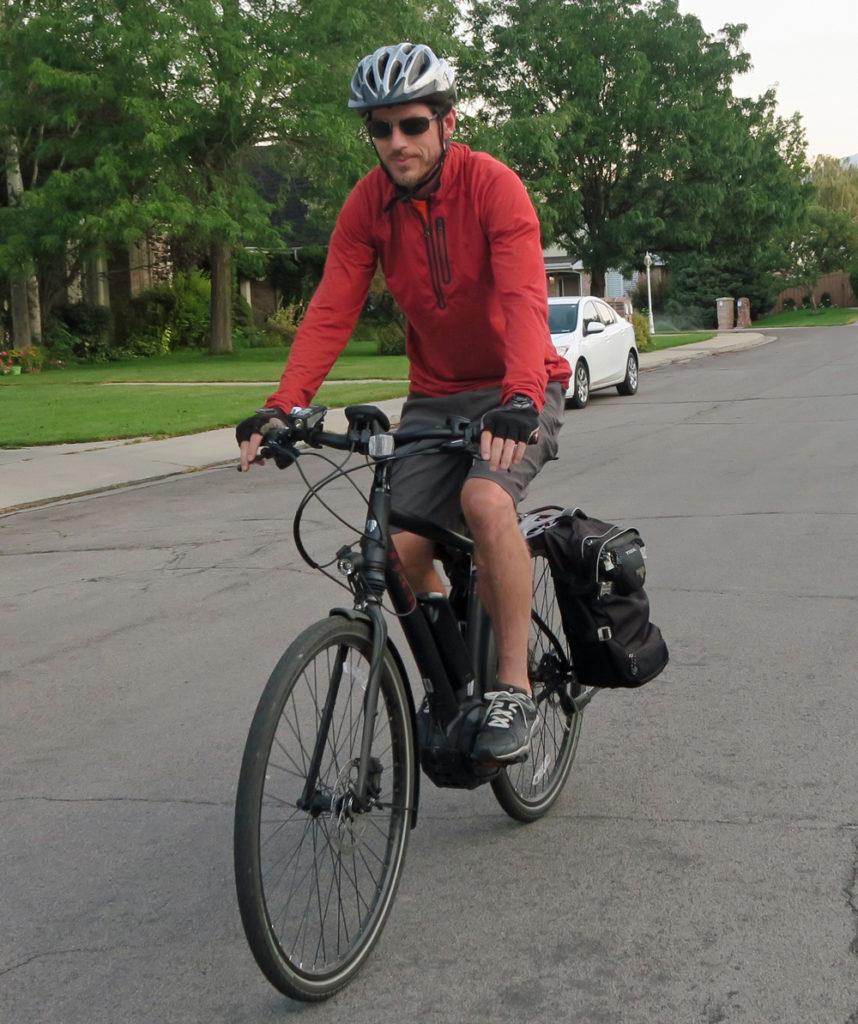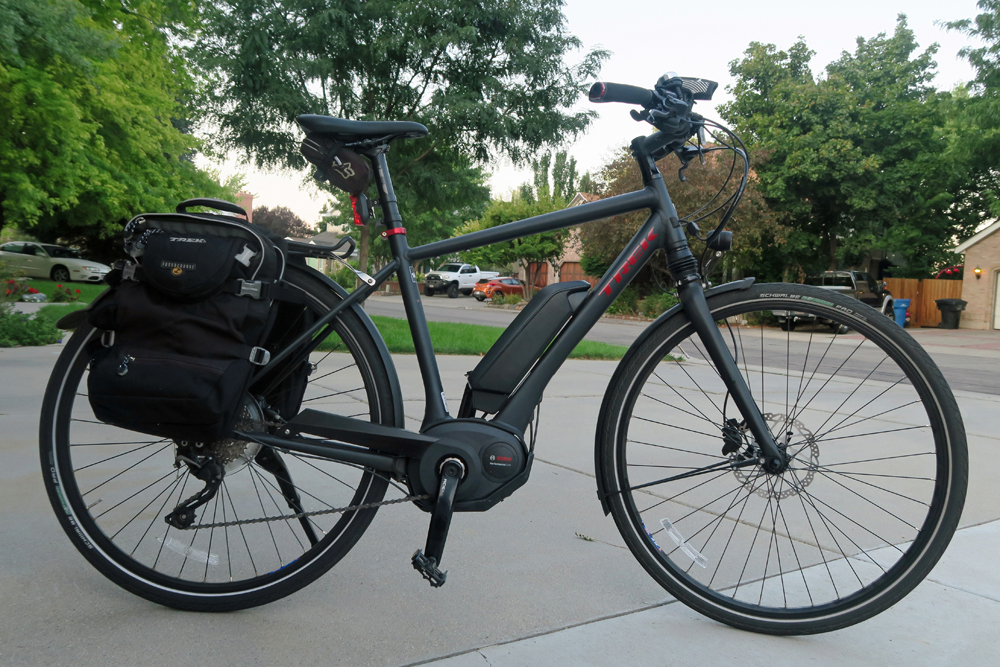By Jamie Morningstar – Kenny Freestone is a Product Director at AncestryDNA. To balance out the inactivity of the of average desk job, Kenny started cycling to work over a decade ago. Kenny faced a new commuting challenge when AncestryDNA relocated to Lehi, about 20 miles from his house. He now uses a pedal-assist eBike to make his 38-mile daily cycle commute possible.
[Editor’s Note: This article was originally published in the September 2017 issue of Cycling Utah, and details herein may no longer be accurate.]

CW: What’s your cycling background? When did you begin cycle commuting?
KF: I’ve enjoyed riding bikes for as long as I can remember. Since elementary school I have ridden both for fun and transportation. I remember riding my bike three blocks down the street to Cascade Elementary School in Orem because it was faster and more fun than walking. After school my friends and I would go ride in the dirt fields around the neighborhood. We built jumps in the dirt, measured how far we could jump, and then would take turns laying down in the dirt so we could jump over each other. It’s a miracle we never sustained injuries more traumatic than skinned knees and elbows.
In high school, I got into mountain biking. The nearby mountain trails were endlessly exciting to explore in almost any weather. I didn’t have a car of my own, so I also frequently rode my bike to school. While commuting to high school I learned the importance of securing my bike – my seat was stolen more than once. High school and college commuting also helped me get used to cold-weather bike commuting. In my early 20’s I took a long break from school to do volunteer work in Italy for my church. I quickly learned the value of helmets when my front wheel separated itself from my bike while riding home one night.
When I was young, I cycle commuted out of necessity. Now I ride my bike because I value the exercise, I like saving money by decreasing my dependency on my car, and I also feel a responsibility to reduce (in however small my way) the air pollution in Utah County.
CW: What is your daily commute like?
KF: A year ago my company relocated to Lehi and my bike commute changed from 3 miles to 19. By car, the new commute is about 15 miles each way, mostly on the freeway. The congestion isn’t too bad for most of the commute, but when the freeway drops to 4 lanes from 6 in Lehi there is often a slow-down. I realized early on that driving in crowded traffic is super lame, plus I-15 is also the state’s deadliest road; it’s a road I like to avoid when possible.
My bike commute route follows the wonderful Murdock Canal Trail for 16 of the 19 miles. The canal trail is mostly flat, but the Ancestry office sits high on a hillside, so my morning commute concludes with a pretty steep climb. The Murdock Canal Trail is perfect for commuting – whenever it intersects a major road there is a bicycle underpass, which means better safety and no stoplights!
Last year I made the 38-mile round-trip commute on my regular unassisted commuter bike, a 2007 Jamis Coda outfitted with a rear rack, panniers, lights, and fenders. The unassisted commute was about 75 minutes door-to-door and was pretty challenging. Because it took so long, I only rode about once per week. I wanted to ride more frequently, and since work wasn’t going to move closer to me, in March 2017 I bought an electric pedal-assist bike to see if the assisted ride would help me ride more frequently.
CW: How did you choose which pedal-assist bike to purchase?
KF: I explored a range of electric bike options, and found some excellent options out there. I also explored buying an electric conversion kit to turn my Jamis commuter into an electric commuter. I was looking for a bike that could be fast, safe, and have the battery range to go at least twenty miles on a single charge. Conversion kits can support most of this, but I had concerns about the bike’s brakes, wheels, and fork being able to hold up to the higher speed.
After lots of shopping and research, I chose the Trek XM7000+. There were lots of factors to consider when making my decision. First, I wanted to buy from an established brand to make sure I would get a trustworthy mechanical quality and safety at speed. Secondly, I was looking for good speed and range. And lastly I was looking for a good value.

The Trek has been a good mix of those priorities. I can ride at between 25 and 27 mph for my entire 19-mile commute. The motor has 5 speed options (off through high). The battery can run the bike at its highest speed for my entire commute. The motor is what they call a pedal-assist motor – it only works as you pedal and there is no throttle option. When you hit 28 mph it stops assisting and you ride on only your own power. The Trek bike was not the cheapest option available, but it was a good choice for me. At around $3,500 it is by far the most I’ve ever paid for a bike.
CW: How does a pedal-assist commute compare to an unassisted ride?
KF: My pedal-assist bike has made it possible to do my daily 38-mile round-trip commute on two wheels. My commute time was reduced from 75-minutes each way on my unassisted commuter bike to about 55-minutes door-to-door, which is only about 30 minutes longer than it would take me in a car. Also, rather than arriving to work sweaty and tired, I’m able to sustain an average speed of about 27 mph with the same effort as a fast walk. It’s still a light workout, but nowhere near the effort of riding unassisted.
The speed of my Trek XM7000+ also took some getting used to. A sustained 27 mph is really fast! It is super fun, but is a different riding experience. For example, the wind is very loud at that speed. I used to put one earbud in and listen to a podcast on the way to work, but that’s no longer feasible because of the wind noise of my pedal-assist bike. Similarly, because I don’t work as hard on the ride I don’t generate as much body heat, so between my higher speed and lower heart rate, those cool 35-degree mornings feel a lot colder than on my unassisted bike.
The electric bike has a few peculiarities that took some getting used to. The chain has fallen off the front sprocket a few times when down-shifting while pedaling, and it took a trip to the bike shop to realize how to correct that. Also, the battery range varies based on wind and temperature. On cooler mornings the range is about 20 miles, and in the warmer afternoons the range can up to 25 miles. Lastly, since the charge lasts about 20 miles, I have to remember to bringing a charger cord with me to the office in addition to my clothes and laptop.
CW: How do other cyclists and trail users react to your pedal-assist bike?
KF: I’ve gotten some curious questions about my bike while on the Murdock Canal Trail, but I’ve never gotten any dirty looks or rude comments. Whatever bike I’m on, I try to be a safe and courteous rider, and my pedal-assist bike is no exception.
The Murdock Canal Trail is a mixed-use trail, and sometimes I have to be patient and wait for joggers and other cyclists to space out a little before passing them. My speed is similar to that of a fast road bike, and like any other faster rider I sometimes have to slow down when the trail gets congested.
CW: What advice would you give to someone considering cycle commuters?
KF: My advice to a new commuter is that commuting is easier than you might think. Regardless of the length or difficulty of your ride, you don’t have to be in Tour de France shape to ride to work. Just allow for extra time until you learn the ins and outs of it all. And if your commute is exceptionally long, there are some great alternatives out there to help you get to work faster and less sweaty, like I discovered with my pedal-assist bike.
You’ll also probably find that things are just better on a bike. For me, the electric bike has changed my approach to transportation. It has made it easier (and funner) to do errands by bike, even just going to the bank or the grocery store.
If you have a suggestion for a commuter profile, have a commuter question, or other comments, please send it to [email protected].

